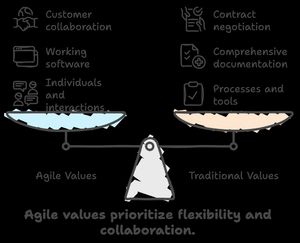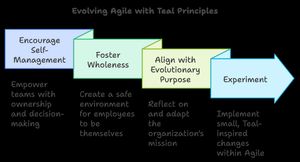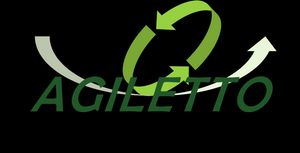What’s Beyond Agile? Exploring the Next Evolution of Organizations
Agile methodologies have completely changed the way we work, especially in fast-paced industries like software development, marketing, and product management. Agile brought principles that shifted the focus to collaboration, continuous improvement, and iterative development, empowering teams to achieve better results with more efficiency and adaptability. For many, Agile feels like the peak of modern business practices. It’s flexible, it’s fast, and it works. For a lot of companies, Agile is the epitome of operational success.
But here’s the thing—what if Agile isn’t the final stop? What if there’s a new level of organizational evolution just beyond the horizon? Something that goes deeper than efficiency and adaptability. Something that taps into more meaningful connections at work, that pushes us to evolve as humans, not just as professionals. In this article, I want to explore that possibility. So, let's do it!

How It All Began
To understand where we’re going, we need to look back at what made Agile such a transformational shift in the first place. When the Agile movement first kicked off, it wasn’t just about changing the way we worked—it was a total shift in mindset. The Agile Manifesto laid out four simple yet powerful value statements that redefined the entire approach to work:

Individuals and interactions over processes and tools
Working software over comprehensive documentation
Customer collaboration over contract negotiation
Responding to change over following a plan
These weren’t just catchy slogans—they represented a seismic change in thinking. Suddenly, people were at the center of the process. The focus moved away from rigid processes and tools and onto real communication. We stopped obsessing over perfect upfront designs and endless contracts and shifted towards collaboration with our customers and teams. It wasn’t just about having plans; it was about knowing that plans would evolve and adapt as we learned more, because we cannot possibly understand everything when we start. It was about this iterative approach, delivering working software, or more modern working solutioon, early and often to the customer.
This was, at its heart, a values-based movement. The real transformation happened when we changed the values and mindset of the people involved. That’s the key—Agile wasn’t about doing things differently; it was about thinking differently. It’s why Agile can’t be done mechanically; it’s a cultural shift, a shift in the values, the mindset, and the entire culture of the organization.
So, Is Agile Enough?
But even if we successfully make that shift—is Agile enough? In many ways, the answer is no. Because, let’s face it, as humans, we’re wired to keep evolving. And while Agile is fantastic for product development, it doesn’t solve all of our problems. The world is facing challenges that Agile alone can’t address.
For instance, Agile often struggles in larger, non-technical industries where cultural, ethical, or even existential issues take center stage. Agile is built around delivering customer value through iterative development, but what about ethical dilemmas that arise, such as when companies introduce AI and face questions of privacy or job displacement? How do we navigate those conversations within a purely Agile framework?
Agile also emphasizes a sustainable pace, but the relentless focus on delivering customer value can still sometimes overshadow broader considerations like work-life balance or employee well-being in practice. Agile isn’t designed to address these deeper, more human-centric concerns. So, naturally, there’s a need for the next step.
But what will it look like? How will it shape the future of work, of organizations, and of us as individuals?
The Nature of the Next Step
Considering the cultural transformation Agile brought us, it’s fair to say that the next step will also need to be transformative. It’ll need to change our beliefs and our ways of thinking, just like Agile did—and is still doing for many. The next step will likely be even more human-centric, one that moves beyond just making great products and begins to address the bigger challenges we face.
I believe the next step will call us to work not just for our companies, but for humanity—for the world at large. It’s going to ask us to tackle the kinds of problems that Agile was never designed to solve, like:
- The ethical implications of AI and automation.
- Striving for world peace in a time of increasing conflict.
- Achieving equality in a world filled with systemic imbalances.
- And a host of other global challenges that demand more than just better workflows.
The next step in organizational evolution will likely focus on purpose, values, and the long-term sustainability of the world and humanity itself. The next step will be much more holistic. The big question is—are we ready for that? And if we are, what does it take to get there?
Enter Teal: A Glimpse Beyond Agile
As we search for what comes after Agile, one concept that’s been gaining traction is the idea of Teal organizations. Introduced by Frederic Laloux in his book Reinventing Organizations, Teal represents an evolutionary leap in how we think about work, leadership, and purpose.
While Agile was a transformative step that shifted the focus to people and adaptability, Teal goes even further—it’s about creating organizations that are self-managing, purposeful, and focused on wholeness.
You might be thinking, “But isn’t that what Agile is doing already?” In some ways, yes. Agile pushed us to rethink rigid hierarchies and traditional management structures. But Teal takes it to another level. It’s less about frameworks and practices and more about changing the very nature of how we organize and lead.
In a Teal organization, self-management replaces hierarchical leadership. Teams govern themselves, decisions are made, nnot by managers, but by the community, and the role of leadership is about empowering everyone to be leaders in their own right, not to manage people. But it’s not just about efficiency or making work faster—Teal brings a deeper purpose into the equation.
Teal organizations are driven by what Laloux calls an evolutionary purpose—the idea that the company itself has a living, evolving reason for being, beyond just profit or market share. And here’s where the real transformation begins: Teal organizations don’t just ask, “How can we be better?” They ask, “Why are we here? What’s our deeper mission?”
This shift from productivity to purpose is what makes Teal such a powerful next step beyond Agile. While Agile helped us respond to change, Teal challenges us to create the change—and to do it in a way that serves not just our businesses, but the world at large.
Why Teal? Why Now?
You might wonder why we should even care about Teal right now, especially if Agile is working well. The truth is, Agile’s focus on adaptability is excellent for delivering products faster, for building software more effectively, and for creating a more flexible workplace. But Agile wasn’t built to tackle the big questions we’re facing today—questions about the environment, inequality, or even the future of technology and society.
Teal offers a framework that not only helps us navigate these challenges but also inspires us to transcend them. In a world where technology is rapidly advancing, where issues like sustainability and social justice are becoming more urgent, Teal gives us a model for organizations that align profit with purpose and innovation with human connection.
So, what does it actually look like to go beyond Agile and into Teal? Well, it’s not about abandoning what works in Agile, but about building on it and evolving further. Just as Agile asked us to rethink how we build products, Teal asks us to rethink how we build organizations—ones that are deeply connected to a higher purpose, where everyone has a voice, and where decisions are made through collective wisdom, not top-down authority.
From Agile to Teal: A Natural Evolution
Before we dive into the Teal mindset, it’s helpful to understand how it builds on the foundations of Agile. Agile methodologies broke away from rigid, hierarchical processes that defined earlier management approaches, emphasizing adaptability, flexibility, and the empowerment of teams. Agile prioritizes:
- Cross-functional collaboration: Teams working closely together, often through daily standups or regular sprints.
- Customer-centric feedback loops: Continuously improving products by responding to feedback in real-time.
- Incremental progress: Breaking down large projects into smaller, manageable tasks that can be adjusted as needed.
Teal organizations take this further by addressing not just how teams work but also why organizations exist and how individuals within those organizations can thrive. In Teal, the focus shifts from operational efficiency to self-management, wholeness, and evolutionary purpose.

Here’s how these three principles go beyond Agile:
Self-Management: Beyond Empowerment
Agile emphasizes empowered, autonomous teams that can make decisions and drive work forward without needing constant approval from higher-ups. However, there is often still a level of oversight, whether through Scrum Masters, Product Owners, or leadership teams that guide the strategic vision.
In Teal organizations, self-management is taken to the next level. There are no traditional managers or hierarchical structures. Teams don’t just decide how to implement tasks—they self-organize around goals, take full ownership of their work, and even handle traditional management responsibilities like budgeting, hiring, and performance reviews.
For example, Buurtzorg, a Teal organization in healthcare, uses self-managed teams of nurses to deliver patient care. These teams handle everything from scheduling to clinical decisions without the need for traditional management roles. The results have been stunning—higher employee satisfaction, better patient outcomes, and significantly reduced overhead costs.
Key Insight for Agile Leaders: Teal’s self-management pushes beyond Agile’s team autonomy. It asks, “How can we trust teams to take on full responsibility for their outcomes, without needing managers to make final decisions?” Agile teams already work autonomously in their tasks, but Teal invites them to self-manage completely.
Wholeness: Bringing Your Full Self to Work
Agile encourages collaboration and interaction, but it typically focuses on work-related contributions. Daily stand-ups, retrospectives, and sprint planning sessions center on improving team performance and product delivery. These activities, while useful, often leave little room for addressing the emotional and psychological well-being of the team.
Teal, however, introduces the concept of wholeness, encouraging organizations to create environments where individuals feel comfortable bringing their whole selves to work—emotions, vulnerabilities, and all. It’s about creating safe, nurturing spaces where employees can express their true selves and thrive as complete individuals, not just workers.
Wholeness can manifest in various ways within teams:
Practical Leadership Behaviors: Leaders in Teal organizations promote authenticity and vulnerability. They lead by example, showing that it's okay to be open about challenges, emotions, or even personal matters when appropriate. This behavior encourages a culture where honesty and empathy are prioritized over simply "getting the job done."
Safe Spaces for Reflection: Teal organizations often incorporate dedicated spaces for reflection or mindfulness. This might be as simple as providing quiet rooms where team members can go to decompress, or as structured as incorporating mindfulness practices, like short meditative breaks, into the daily routine.
Emotional Check-Ins: Beyond traditional work check-ins, teams might begin meetings with emotional check-ins where each person shares how they’re feeling, not just their project status. This builds empathy and helps the team understand each other’s emotional states, leading to more compassionate and thoughtful collaboration.
Personal Growth Conversations: In addition to performance reviews, Teal organizations offer personal growth conversations that focus not just on work performance but on how employees are growing as individuals. The goal is to align personal development with organizational needs, ensuring that employees’ personal values and the company’s purpose are in harmony.
For example, organizations like Patagonia are allegedly known for fostering wholeness by promoting values that reflect their employees’ personal beliefs, such as sustainability and social responsibility. This alignment between personal purpose and organizational mission reportedly creates a sense of meaning and fulfillment beyond day-to-day tasks.
Key Insight for Agile Leaders: In Agile, teams are empowered to collaborate and improve processes, but in Teal, the focus is on nurturing the whole person. The challenge for Agile leaders is to ask: "How can we create environments where people feel safe, connected, and valued not just for what they do but for who they are?"
Evolutionary Purpose: More Than Just Delivering Value
Agile methodologies are often customer-centric, focusing on delivering value through regular feedback loops and iterative progress. However, Agile typically assumes that the purpose of the organization or project is predetermined—the role of the team is to deliver on that purpose as efficiently as possible.
In Teal organizations, purpose isn’t fixed, and it is not centered around just the organization or its owners. Instead, it evolves based on the needs of the community, the environment, and the organization itself. In Teal, purpose is seen as a living entity, emerging organically rather than being dictated from the top down by leadership. It’s not just about asking “What should we produce?” but rather “Why are we here, and what should we be contributing to the world?”
Evolutionary purpose is about continuously reflecting on how the organization can best serve not only its customers but society, the environment, and the community at large.
Some practical ways this concept plays out:
Dynamic Strategic Planning: Rather than having a static mission statement or long-term strategic goals, Teal organizations engage in continuous reflection on their purpose. They use feedback loops not only to improve products but also to reassess whether their mission and impact are evolving in alignment with societal or environmental needs.
Purpose-Driven Decision Making: Decisions in Teal organizations are not solely profit-driven. Instead, they ask questions like, “Will this action contribute to the broader community or environment in a meaningful way?” This approach requires businesses to balance their financial objectives with their ethical responsibilities.
Evolving Product Lines: For more traditional businesses, embracing evolutionary purpose might look like constantly refining or even expanding product lines to align with new customer and societal values. For example, a clothing manufacturer might begin as a fashion brand but, over time, evolve into a company that prioritizes sustainability in its supply chain, promoting ethical labor practices and eco-friendly materials. This evolution in purpose might emerge as the company listens to its customers and responds to a growing awareness of environmental issues.
Employee-Driven Purpose: In Teal organizations, purpose evolves not just from the top but from the ground up. Employees are encouraged to bring forward ideas and initiatives that align with both personal values and organizational goals. This could mean suggesting new services, products, or business models that better align with emerging social or environmental concerns.
For example, Yangi, a Swedish company for which I have consulted, doesn’t just aim to sell packaging solutions; part of its purpose is to protect the planet and protect the future. This purpose is not static—over time, it is evolving to include more direct action in everything this Swedish startup engages with.
A more traditional business example could be Unilever, which has reportedly evolved from a consumer goods company focused on soap and food products to a company prioritizing sustainability in its business practices. Unilever's shift is an example of how a company’s purpose can evolve to reflect new societal values while still maintaining business viability.
Key Insight for Agile Leaders: Agile helps deliver value incrementally, but Teal asks: "What is the evolutionary purpose of our organization? How can we create a dynamic purpose that evolves over time and reflects not just customer needs but societal and environmental well-being?"
How to Start Moving Beyond Agile
If Agile is working well for your organization, you may wonder whether there’s a need to move beyond it. However, the Teal approach isn’t about discarding Agile—it’s about evolving it. Here’s how you can start applying Teal principles in your Agile organization:

Encourage Self-Management: Start by giving your Agile teams more ownership. Can they manage their budgets? Can they handle hiring decisions? Trust your teams to take on more responsibility and see how they rise to the challenge.
Foster Wholeness: Create environments where employees feel safe bringing their whole selves to work. This might involve more open discussions in retrospectives about how people feel or creating spaces for reflection and mindfulness.
Align with an Evolutionary Purpose: Encourage your teams and organization to reflect on why they exist. Is your purpose static, or does it evolve? Consider how you can adapt your mission to serve not just customers but a broader societal or environmental goal.
Experiment: Take small steps, evaluate, and learn. Teal organizations don’t emerge overnight. Start by taking one step inward—introduce small, Teal-inspired changes and align them with existing Agile structures. Gradually, you’ll start to see how these deeper shifts transform the way your organization operates.
Conclusion: The Future Is Teal
Agile has revolutionized the way we work, but for organizations ready to evolve further, Teal offers an exciting new frontier. By embracing self-management, wholeness, and evolutionary purpose, Teal organizations create environments where individuals and teams thrive—not just as productive units but as whole people contributing to a greater purpose.
For Agile practitioners, the journey to Teal is a natural progression. It builds on Agile’s strengths while encouraging a deeper level of transformation. Teal isn’t about abandoning Agile—it’s about expanding it to create more holistic, meaningful work environments. So, what’s beyond Agile? In my view, the answer is Teal—a more evolved way of working that balances productivity with purpose, connection, and meaning.
At a time when some companies are considering rolling back their Agile transformations—returning to management-driven, top-down, profit-focused models—I believe that’s not just the wrong move; it borders on insanity. I've explored the common mistakes made during Agile transformations in an article series revealing the real issues behind these flawed efforts. Instead of stepping backward, we should be looking forward and asking ourselves: What’s next? What comes after Agile? And we should start aiming toward that future.
So, what’s stopping you from taking the next step toward Teal? Share your thoughts in the comments or reach out—I’d love to hear your view.
Last updated May 27, 2025
